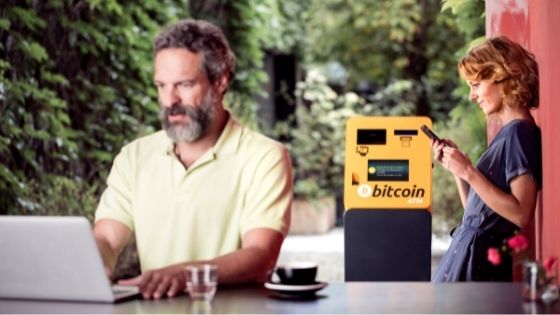You’ve decided to become a Bitcoin investor. You’re totally convinced that cryptocurrency isn’t just a phase and you’re ready to go all in. But despite your good intentions, there’s a problem that’s keeping you from taking the plunge:
You’re not sure how to go about actually funding into your Bitcoin wallet.
For a convenient option that isn’t a crypto exchange, you could try using a Bitcoin ATM. These machines give you the convenience of a traditional ATM that deals in cryptocurrency instead of traditional cash.


Should Bitcoin ATMs be on your radar? Could that ATM map be the engine that’ll make all your cryptocurrency dreams come true? Keep reading to find out what you should keep in mind as you explore your Bitcoin ATM options.
1. Not All ATMs are Created Equal
Right after that initial “I had no idea Bitcoin ATMs existed!” response, many aspiring crypto investors are blown away by the realization that different ATMs are equipped with different capabilities. And depending on your network provider, your neighborhood, and your general area, ATM capabilities can change dramatically from area to area.
Some, for instance, will only allow you to purchase Bitcoin and send it to your digital wallet. Others will allow you to withdraw cash. And still, others will give you a convenient means of selling your coins at market prices if you ever decide that you need to cash out.
As such, even if you think that Bitcoin ATMs are the greatest invention ever, it’s still possible that you may need to have a secondary transaction plan. Why? Because if your local ATM only allows you to purchase cryptocurrency, for instance, you’ll still need a mechanism that’ll allow you to cash out.
In addition, some ATMs may be operating with faulty software or a delay. And if you’re an especially busy person, you might not have the time or the patience to deal with the quirks of every crypto ATM in your area.
For these reasons and more, you’ll want to spend some time carefully vetting the Bitcoin network you’re dealing with.
2. You’ll Likely Need to Provide ID
Bitcoin and the blockchain are often touted as major wins for privacy-minded individuals. After all, unlike the bank, you don’t have financial institutions and governments breathing down your neck when you buy or sell Bitcoin, right?
Well, not exactly.
To prevent money laundering and other forms of financial crime, many financial service providers — Bitcoin ATMs included — will subscribe to what’s known as Know Your Customer legislation. What this means in practice is that ATM providers will require some form of government-issued ID before they’ll process your transaction.
Depending on where you live, finding acceptable ID isn’t always easy. But the good news is that when you go through a network like bytefederal.com, the whole process of finding an ATM and providing your ID is fairly straightforward.
3. A Wallet is Needed to Access Your Crypto
Imagine going to the grocery store and attempting to buy food with a debit card that has no bank account attached to it. All things being equal, the transaction likely wouldn’t work, right?
Believe it or not, there’s a similar dynamic at play with your cryptocurrency transactions. And, to keep the analogy going, your Bitcoin wallet is essentially the crypto version of a bank account. Without a wallet, the Bitcoin ATM won’t know where to send the money.
The good news is that setting up a crypto wallet is a relatively simple process. So much so that if you’re so inclined, you can open an account for free and start funding it within hours.
As a general rule of thumb, there are two types of crypto wallets to choose from:
- Hot wallets
- Cold wallets
Hot wallets are connected to the internet while cold wallets will store your funds offline. Both approaches have their strengths and weaknesses.
For starters, online wallets are fantastic for people who aren’t tech-savvy. If you opt for a browser-based solution, the process might feel a lot like signing up for a new email service provider or an app. In addition, Bitcoin investors who want their funds to be readily accessible for trading have a lot to gain from holding their coins in an internet-based wallet.
But the downside of using a hot wallet is that you’re often depending on a third party to protect your coins from hackers and malicious actors.
Cold wallets, by way of contrast, are highly touted for their next-level security. And whether you opt for the USB-like version or the paper and pencil-based one, these offline methods of crypto storage really do allow you to exert more control over your funds.
Whichever storage method you choose, however, you’ll want to have your information ready when you visit the Bitcoin ATM.
4. The Location
As it turns out, the words, “Location, location, location!” aren’t just a catchy phrase for real estate agents to yell out. The location of your Bitcoin ATM is very relevant to your ability to regularly use it.
Are you familiar with the neighborhood in question? Is the ATM located in a well-lit and spacious area? How do current state and federal regulations affect your ability to deposit and withdraw Bitcoin?
From a personal safety standpoint, you won’t want to be using a sketchy ATM in an equally questionable part of town. In addition, if you’ve got a brutal commute or if you’re constantly having to register and re-register across multiple ATM networks, you might have a harder time using your local Bitcoin ATM options.
While the location of a Bitcoin ATM might not be an absolute deal breaker for you, it is worth keeping in mind as you plan your next deposit.
5. There May Be Transaction Restrictions
Have you ever noticed how a lot of crime shows will talk about how the bank is required to report transactions of over $10,000 to the IRS? It turns out that this is an example of Hollywood telling the truth.
In the same way that banks and other financial institutions will often have transaction limits, Bitcoin ATM providers also have regulations that they need to comply with. As such, it’s not unusual to see Bitcoin ATM transactions being capped at $3,000, $10,000, or even $20,000.
If you’ve got tuition fees or medical bills to pay, you might have to be patient. And if you’re in a hurry, you’ll want to verify the transaction limit of the ATM before you commit to taking a trip.
6. Don’t Forget to Factor in the Fees
Be honest.
Have you ever had an “I can’t believe I forgot to calculate the taxes!” moment? It seems like now more than ever, companies are constantly adding surcharges, service fees, and tips. So much so, that it’s hard not to feel burned by all those hidden costs sometimes.
Bitcoin ATMs will typically allow you to purchase or sell your cryptocurrency at standard exchange rates. In addition, you’ll likely also notice a service fee that’s been assessed to your transaction amount. This will typically be calculated based on a percentage rate.
Like most items, your best shot at finding a Bitcoin ATM network that also has clear and transparent fees is to spend some time shopping around. This will not only give you a chance to see how different providers operate — it’ll also allow you to get a sense of general market prices.
At the end of the day, no one wants to feel like they’re a victim of price gouging. This step of the Bitcoin ATM assessment process gives you a genuine chance to save money.
7. The ATM Can Be Used to Transfer Money to Other Wallets
Pop quiz.
You’ve got a friend or a family member who’s stranded in another country. All the banks are closed and Bitcoin is the only funding source you can spare. Can a Bitcoin ATM be useful in this situation?
The answer to that question is, “Absolutely!”.
Although most people will likely be transferring money over to their own wallets, you can also use the ATM to quickly and cheaply send money over long distances. As long as you have the number of the wallet you’re donating to, Bitcoin ATMs can simplify the process of sending money to other places.
8. Pay Attention to Your Processing and Verification Times
We’re going to let you in on a little secret:
Some Bitcoin ATMs are significantly more inconvenient to use than others.
For example, it’s possible to find Bitcoin ATMs that process transactions with the speed of a Ferrari on the Autobahn. But by the same token, others might take hours or days to complete the process of verifying your ID and your transaction.
On a personal level, this can be quite nerve-wracking. What happens if the machine rejects your funds? How will this impact your ability to handle a time-sensitive post-deposit transaction?
Once you get accustomed to the way that your Bitcoin ATM works, these details might not bother you too much. But even so, it’s a good idea to factor these turnaround times into your investment process.
9. Your Payment Options
Okay.
Let’s say that you’ve found a Bitcoin ATM. The neighborhood is fairly close to yours, the fees are reasonable, and transactions are processed in a timely manner. You’ve hit the jackpot, right?
Well, not entirely. Why?
Because not all Bitcoin ATMs are prepared to accept every standard payment option. So for instance, if you’re the type of Bitcoin investor who likes to put everything on the credit card, you might not have an ATM in your area that’s capable of meeting your needs.
Is the ATM you’re looking at primarily cash only? You may need to stop over at your bank before you make your purchase. And as a general rule of thumb, if you’re focused on one payment option or the other, you may find yourself having to travel long distances to reach your ideal ATM.
10. Your Interest in Selling Crypto
For many people, Bitcoin investing isn’t just about buying crypto and holding on to the coins forever — the money is also a key part of having solid personal cash flow.
We get it.
However, unlike regular ATMs that will often allow you to deposit and withdraw cash in the same transaction, many Bitcoin ATMs are deposit-only. So if your plan is to deposit funds before making a withdrawal, you might have to get creative.
For instance, peer-to-peer lending networks can often allow you to offload your currency quickly. And although you don’t necessarily know the person you’re meeting and selling to, the combination of the Bitcoin ATM deposit, the passphrase, and the peer-to-peer sellers can give you the one-two punch you need.
However, all things being equal, you can’t just assume that your local ATM is a two-way machine. For these reasons and more, you’ll want to take note of where the deposit-and-withdrawal ATMs are.
Should You Be Using a Bitcoin ATM?
When they’re laying down their investment foundation, most Bitcoin investors need an answer to the question:
How can I quickly and easily buy and sell Bitcoin?
Some people use crypto exchanges. Others opt for platforms and peer-to-peer lending opportunities. But if you want convenience, speed, and greater control over your money, using a Bitcoin ATM can deliver on all fronts.
When you consider the ten factors we’ve listed just now, you won’t just be exploring your Bitcoin ATM options — you’ll be managing your full-fledged portfolio with relative ease.
Was this article helpful to you? Check out the rest of our site to find more content like this!

























